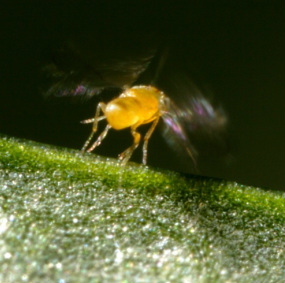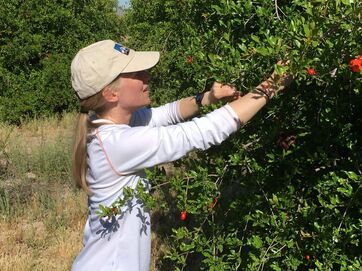Current research projects
 Photo credit: Suzanne Kelly
Photo credit: Suzanne Kelly
Mechanism of cytoplasmic incompatibility caused by Cardinium in parasitoid wasps (NSF, Marie Curie)
Cytoplasmic incompatibility (CI) is a symbiont associated reproductive manipulation that has long intrigued biologists for its subtlety. At its simplest, female hosts fail to produce viable offspring when infected males mate with uninfected females, a phenomenon that favors the survival of symbiont-infected insects. CI is associated primarily with Wolbachia (alpha-Proteobacteria), and recent efforts by John Beckmann, Seth Bordenstein and colleagues have revealed key genes that cause both modification of the sperm and rescue by the egg cytoplasm when it is infected with related symbionts. We are adopting a comparative framework for examining CI in an unrelated bacterium, Cardinium (Bacteroidetes), drawing on Penz et al. (2012) Cardinium genome. Cardinium and Wolbachia have very few genes in common, suggesting convergent evolution of the CI phenotype. We compared expression of Cardinium genes in male and female Encarsia suzannae, a project led by Evelyne Mann and Stephan-Schmitz-Esser and now published in MSystems (2017). We also examined how CI-Cardinium causes embryonic death by cytological analysis of living embryos. This work was led by EU Marie Curie Postdoctoral Fellow Marco Gebiola and is now published in Proceedings of the Royal Society (2017). Corinne Stouthamer led an effort to sequence and compare more Cardinium genomes (MS in preparation), including one more CI genome. Matt Doremus has been studying temperature effects on the CI phenotype (MS in review) and will also be exploring CI Cardinium mechanism. We expect that the tractability of this experimental system and the comparative insights it can provide will ultimately enhance understanding of CI in Wolbachia as well as Cardinium. This project is in collaboration with Stephan Schmitz-Esser at Iowa State University and Evelyne Mann at the Veterinary Medicine University in Vienna, Austria, and Marco Gebiola is now at UC Riverside. (Matt Doremus, Corinne Stouthamer, Suzanne Kelly).
Cytoplasmic incompatibility (CI) is a symbiont associated reproductive manipulation that has long intrigued biologists for its subtlety. At its simplest, female hosts fail to produce viable offspring when infected males mate with uninfected females, a phenomenon that favors the survival of symbiont-infected insects. CI is associated primarily with Wolbachia (alpha-Proteobacteria), and recent efforts by John Beckmann, Seth Bordenstein and colleagues have revealed key genes that cause both modification of the sperm and rescue by the egg cytoplasm when it is infected with related symbionts. We are adopting a comparative framework for examining CI in an unrelated bacterium, Cardinium (Bacteroidetes), drawing on Penz et al. (2012) Cardinium genome. Cardinium and Wolbachia have very few genes in common, suggesting convergent evolution of the CI phenotype. We compared expression of Cardinium genes in male and female Encarsia suzannae, a project led by Evelyne Mann and Stephan-Schmitz-Esser and now published in MSystems (2017). We also examined how CI-Cardinium causes embryonic death by cytological analysis of living embryos. This work was led by EU Marie Curie Postdoctoral Fellow Marco Gebiola and is now published in Proceedings of the Royal Society (2017). Corinne Stouthamer led an effort to sequence and compare more Cardinium genomes (MS in preparation), including one more CI genome. Matt Doremus has been studying temperature effects on the CI phenotype (MS in review) and will also be exploring CI Cardinium mechanism. We expect that the tractability of this experimental system and the comparative insights it can provide will ultimately enhance understanding of CI in Wolbachia as well as Cardinium. This project is in collaboration with Stephan Schmitz-Esser at Iowa State University and Evelyne Mann at the Veterinary Medicine University in Vienna, Austria, and Marco Gebiola is now at UC Riverside. (Matt Doremus, Corinne Stouthamer, Suzanne Kelly).
The leaf-footed bug Leptoglossus zonatus, and its environmentally-acquired gut symbiont, Burkholderia (USDA AFRI)
There are clear potential benefits to be gained from symbiont that comes from the environment each generation. A host that acquires a locally-adapted symbiont may also acquire locally relevant functions, something that has been shown by Kikuchi and colleagues with respect to pesticide resistance conferred by Burkholderia to the soybean bug, Riptortus pedestris. Free-living bacteria like Burkholderia also have large genomes and a range of metabolic capabilities. On the other hand, environmental symbionts can be risky – they could be pathogenic, or not do what the bug expects, or perhaps most seriously, they might not be always available.
We have recently started studying the transmission and function of the free-living bacterium, Burkholderia for Leptoglossus zonatus, a pest of pomegranates. We are broadly interested in the spatial structuring of bug-associated Burkholderia strains in nature, the function of symbiont for the bug, whether the function varies with Burkholderia strain, and how the symbiont is transmitted. We’ve shown that Burkholderia is virtually obligate for L. zonatus– nymphs that do not acquire the symbiont are likely to die before adulthood, and if they do become adults, they are about half the weight of symbiotic bugs. This project grew out of another Burkholderia-bug system that we studied for a couple of years involving another charismatic (berytid) bug Jalysus wickhami. We found similar, although not quite as dramatic benefits of Burkholderia for J. wickhami, and evidence of very local (by individual plant) structuring of Burkholderia strains. We discontinued study of J. wickhami because it was a challenging lab system. The bug-Burkholderia project is a collaboration including Alison Ravenscraft and Dave Baltrus (co-PIs of the USDA grant) and Suzanne Kelly.
There are clear potential benefits to be gained from symbiont that comes from the environment each generation. A host that acquires a locally-adapted symbiont may also acquire locally relevant functions, something that has been shown by Kikuchi and colleagues with respect to pesticide resistance conferred by Burkholderia to the soybean bug, Riptortus pedestris. Free-living bacteria like Burkholderia also have large genomes and a range of metabolic capabilities. On the other hand, environmental symbionts can be risky – they could be pathogenic, or not do what the bug expects, or perhaps most seriously, they might not be always available.
We have recently started studying the transmission and function of the free-living bacterium, Burkholderia for Leptoglossus zonatus, a pest of pomegranates. We are broadly interested in the spatial structuring of bug-associated Burkholderia strains in nature, the function of symbiont for the bug, whether the function varies with Burkholderia strain, and how the symbiont is transmitted. We’ve shown that Burkholderia is virtually obligate for L. zonatus– nymphs that do not acquire the symbiont are likely to die before adulthood, and if they do become adults, they are about half the weight of symbiotic bugs. This project grew out of another Burkholderia-bug system that we studied for a couple of years involving another charismatic (berytid) bug Jalysus wickhami. We found similar, although not quite as dramatic benefits of Burkholderia for J. wickhami, and evidence of very local (by individual plant) structuring of Burkholderia strains. We discontinued study of J. wickhami because it was a challenging lab system. The bug-Burkholderia project is a collaboration including Alison Ravenscraft and Dave Baltrus (co-PIs of the USDA grant) and Suzanne Kelly.

Second instar Leptoglossus nymphs need to pick up the bacterium Burkholderia from the environment. One of our current projects, led by Liam Sullivan, is to try and understand if these small and delicate arboreal insects are ever limited in their ability to find and and ingest the free-living bacterium that is ordinarily found in the soil. (Nice photo by Mike Raupp!)
 Photo credit: Scott Bauer, USDA ARS
Photo credit: Scott Bauer, USDA ARS
This project is now finished: Rickettsia influence on sweetpotato whitefly, Bemisia tabaci (NSF, USDA, BARD).
Rickettsia is a common secondary endosymbiont of arthropods, and best known for the arthropod-born diseases of humans that some lineages cause, like typhus and Rocky Mountain Spotted Fever. We found that Rickettsia raced through southwestern whitefly populations, increasing from 1% to 97% in 6 years (2000-2006), and is associated with large fitness benefits and female-biased sex ratios in its host. Since then we’ve been exploring the mechanism of the fitness benefit and at the effects of Rickettsia on whitefly life history and reproduction. We’ve looked at the frequency of Rickettsia infections across the US, the effects of Rickettsia on whiteflies in the field, on temperature shock and stress. We’ve also looked at the effects of Rickettsia on susceptibility to the fungal pathogen, Beauveria bassiana (Rickettsia is protective) and on the contributions of cytotype and nuclear genotype to the expression of the Rickettsia-associated phenotype. Recently, Alison Bockoven and Liz Bondy found that the frequency of Rickettsia in Arizona is dropping. This paper is in review at Microbial Ecology. This project was largely in collaboration with Einat Zchori-Fein and her group at the Agricultural Research Organization in Israel. (Project alumni: Alison Bockoven, Bodil Cass, Liz Bondy, Suzanne Kelly, Jimmy Conway, Anna Himler and Peter Asiimwe).
Rickettsia is a common secondary endosymbiont of arthropods, and best known for the arthropod-born diseases of humans that some lineages cause, like typhus and Rocky Mountain Spotted Fever. We found that Rickettsia raced through southwestern whitefly populations, increasing from 1% to 97% in 6 years (2000-2006), and is associated with large fitness benefits and female-biased sex ratios in its host. Since then we’ve been exploring the mechanism of the fitness benefit and at the effects of Rickettsia on whitefly life history and reproduction. We’ve looked at the frequency of Rickettsia infections across the US, the effects of Rickettsia on whiteflies in the field, on temperature shock and stress. We’ve also looked at the effects of Rickettsia on susceptibility to the fungal pathogen, Beauveria bassiana (Rickettsia is protective) and on the contributions of cytotype and nuclear genotype to the expression of the Rickettsia-associated phenotype. Recently, Alison Bockoven and Liz Bondy found that the frequency of Rickettsia in Arizona is dropping. This paper is in review at Microbial Ecology. This project was largely in collaboration with Einat Zchori-Fein and her group at the Agricultural Research Organization in Israel. (Project alumni: Alison Bockoven, Bodil Cass, Liz Bondy, Suzanne Kelly, Jimmy Conway, Anna Himler and Peter Asiimwe).
This project is finished, and papers published:
The role of cytoplasmic incompatibility Cardinium in reproductive isolation of sibling Encarsia species (Marie Curie PIOF-GA-2012-327425)
Marco Gebiola, a Marie Curie Postdoctoral Fellow from CNR in Napoli, Italy, initiated a project to understand the relative role of cytoplasmic incompatibility (CI) Cardinium and nuclear incompatibilities (NI) in reproductive isolation, speciation, and interspecific competition of two sibling Encarsia species. Cardinium-induced CI occurs in the parasitoid wasp Encarsia pergandiella, a natural enemy of agricultural pest whiteflies, and is likely to have implications for its use in biological control. For example, CI may lead to a suppression of population growth when populations with a different infection status interact. In laboratory experiments, we are studying the role of Cardinium in reproductive isolation by crossing antibiotic cured and Cardinium-infected Encarsia pergandiella (TX) with naturally uninfected Encarsia pergandiella (CA). We have found we can partition dead offspring to ones that died from CI or NI, thus better understanding the relative strength of these two types of isolation in this interaction. Further, mating trials among the different types of wasps show asymmetry in mating that appear to give one species an advantage and perhaps reflect the historical importance of CI in keeping the species apart in the other direction. Lastly, population cage experiments were performed to evaluate the population interactions of these species, and to help evaluate the potentially disruptive effects of an introduction of a biological control agent that is partially reproductively isolated (via CI or NI) on biological control provided by an established, conspecific parasitoid population. This project is now continuing for its third year in Napoli, where ecological interactions of the two species will be studied at the larger scale of greenhouses.
|
This research is currently supported by the National Science Foundation, USDA NIFA (AFRI), and and has been supported by the US-Israel Binational Science Foundation (BSF), The US-Israel Binational Agricultural Research and Development (BARD) program, the NIH-supported PERT Postdoctoral program (through the Center for Insect Science) and the EU Marie Curie Postdoctoral Fellowship program.
|














